EXHIBIT
REVIEWS
LITTLE GIRLS WITH DREAMS BECOME WOMEN WITH VISION
“DREAM, ACT, FAIL & REPEAT”
A selection of lovely reviews of the public preview of my ” Life in Colour” exhibition which was held on 12th October 2018 at Sunderland Museum & Winter Gardens. I would like to give a big thanks to Arts Council England, Sunderland City Council, Sunderland Culture, all the wonderful staff at the Sunderland Museum & Art Gallery, Esen Kaya (Curatorial Lead), Padma Rao (Facilitator, Sangini a Friend), Five12 Design (photography and video).
MULTI-DIMENSIONAL ART
Written by: Harminder Kaur Bhogal, Co-founder, Strategy and Operational Manager of Community Education Academy of Leadership (CEAL) (www.ceal.org.uk)
Ranbir Kaur’s preview of her very own exhibition amplified her life time achievement and in particular her 30 years in this country as an artist.
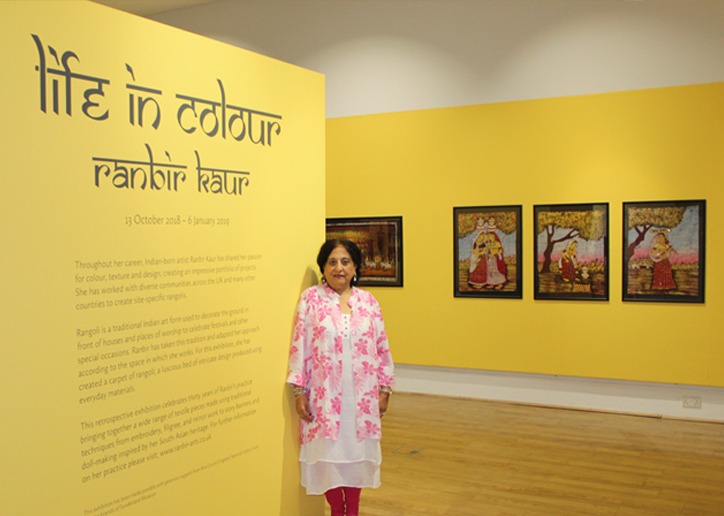
Ranbir Kaur’s journey began as a child and her artistic gift was noticed early on, ”My mother would say, your written words are like pearls sewn together’’. I took great length to ensure that my handwriting was perfectly curved in those days and I just wanted to get it right, I was inspired by shapes and the symmetrical drawings. As a child, I would sit on my dad’s tummy, drawing perfect circles with my finger. Growing up, her interest in art developed into unquestionable passion to study at a higher level which resulted in acquiring BSc in Arts in University of Uganda with Rangoli as subject specialism.
Ranbir’s dreams of working as an artist in East Africa abruptly ended when a different type of politics came into play. In early August 1972, the President of Uganda, Idi Amin, ordered the expulsion of his country’s South Asian minority, giving them days to leave the country. ‘’I remember, when soldiers barged in our house, one pointed the rifle and ordered us to leave, I reached out to pick up my doll that I had created. The soldier motioned with a gun, that meant two things either leave or die. I looked at my father and he fearing for our safely murmured, ‘’leave the doll, I will buy you many more’’. We left, not taking a single one of our belongings with us. We left our homeland for India that I knew very little about, despite being born there, I came to East Africa, 22 days old.
With my qualifications, skills and the specialism in Rangoli art, my talent was quickly recognised and I started to teach Pedagogy of Art at The Guru Nanak School in Delhi. For me, art means discipline; the teaching helped to reinforce it further. ‘’you see that is the reason, I am never late for anything’’, Ranbir muses. I bore 2 beautiful daughters and it was my personal circumstances that led me to this country 30 years ago. My third daughter was born here in England.
Back in India, my parents were always a pillar of support for me, I came here and got noticed by local schools and education authorities, soon I became a sought after artist. In the earlier days, I was nervous, not knowing the decision makers or the right people. At that time, it were people like Sudha Daniels (Art Specialist) and Sarjit Singh, the later she fondly calls ‘uncle ji’. Ranbir adjusted to raising her young children, doing school runs and working long hours. ‘’Without uncle ji, all the success would not have been possible, he was there, every step of the way’’. Sarjit Singh was a veteran educator and a literary artist himself. Incidentally, both men, Ranbir’s father and Sarjit Singh were friends in East Africa. ‘’Uncle ji was my angel sent by God to help guide me’’. He was a great influence on my children (now a medical doctor, Police Inspector and Public Relations Officer, respectively)”. Notably, the great uncle passed away in 2015 leaving his own legacy of strength and valour.
On the eve of opening of the exhibition to the public, Ranbir included her uncle’s memory in her speech. She made history not just as an artist but as a gentle yet steely woman who will continue to inspire generation to come. She ended on the note, ‘’my job is done’’, yes, it is done, but the job of those who are yet to learn of her work be they are academicians, artists, politicians, policy makers and/or the general public or mainstream media people is yet to be done. Ranbir’s works should be publicised in national newspapers such as The Observer and The Guardian as well as broadcast media that edify or demonstrate an interest in genuine art and creativity.
Tellingly, the display of her life time work seduced the audiences no end. It was though, the captivating expressions that spoke largely and not the words. Quiet voices were heard echoing the praises of Ranbir’s work as people mustered through the exhibition hall. The faces said everything that words alone were not enough to describe her work. There were look of awestruck, swooned gazes, quiet contemplations, consternation expressions, captivating gazes, glinting eyes and absorbing gazes. As if these weren’t enough, it seemed that the countless circling of the exhibition spaces, suddenly and mysteriously created a pilgrimage or mecca- type atmosphere for viewers and other wider audiences from all walks of life. Indeed, the absorption of this multidimensional art phenomenon was truly historic for a city renowned for its port, trading and salt.
Ranbir’s unique work in the textile art genre can be seen at the Sunderland Museum: https://www.sunderlandbid.co.uk/events/life-colour-ranbir-kaur
Photographs of the exhibition opening were taken by Graham Tranter of Five12 Design, a West Midlands based Graphic/Web/Media company. One of their primary aims is to help organisations achieve professional brand and identity at highly competitive prices. ask@five12design.co.uk
The exhibition will be installed at the Wednesbury museum in Sandwell, West Midlands next year.
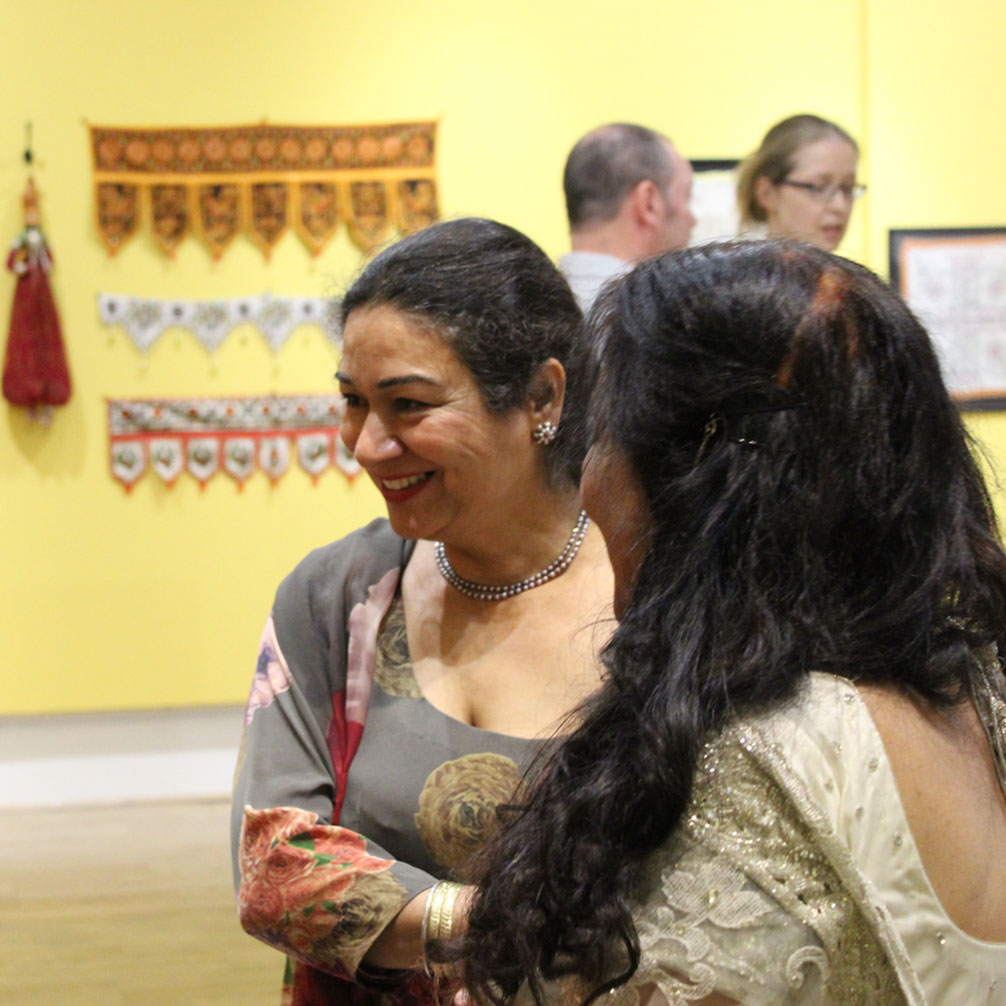
Ranbir and Harminder exploring her wonderful exhibition.

Ranbir Kaur’s ‘pillar of strength’ her uncle, the late Sarjit Singh Myrrpurey MBA.
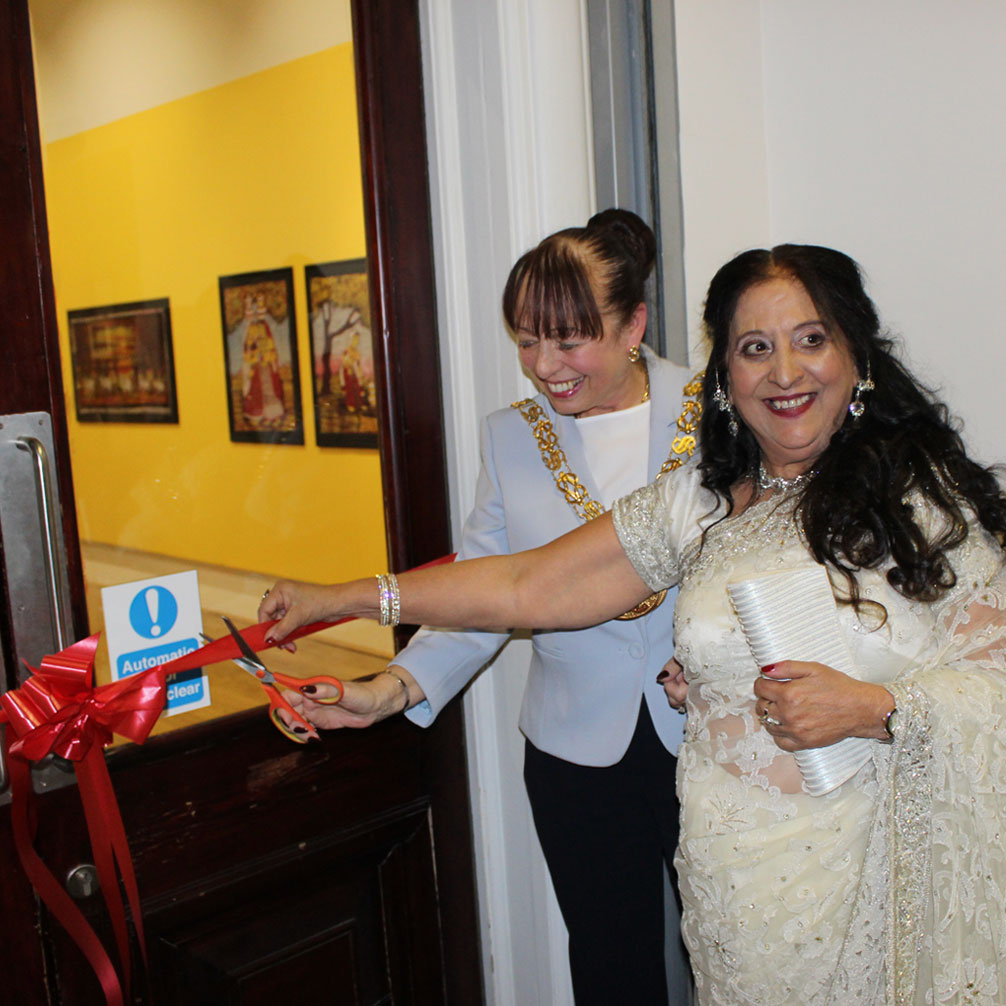
The Right Worshipful the Mayor of the City of Sunderland, Lynda Scanlan with Ranbir Kaur marking the official opening of the exhibition.
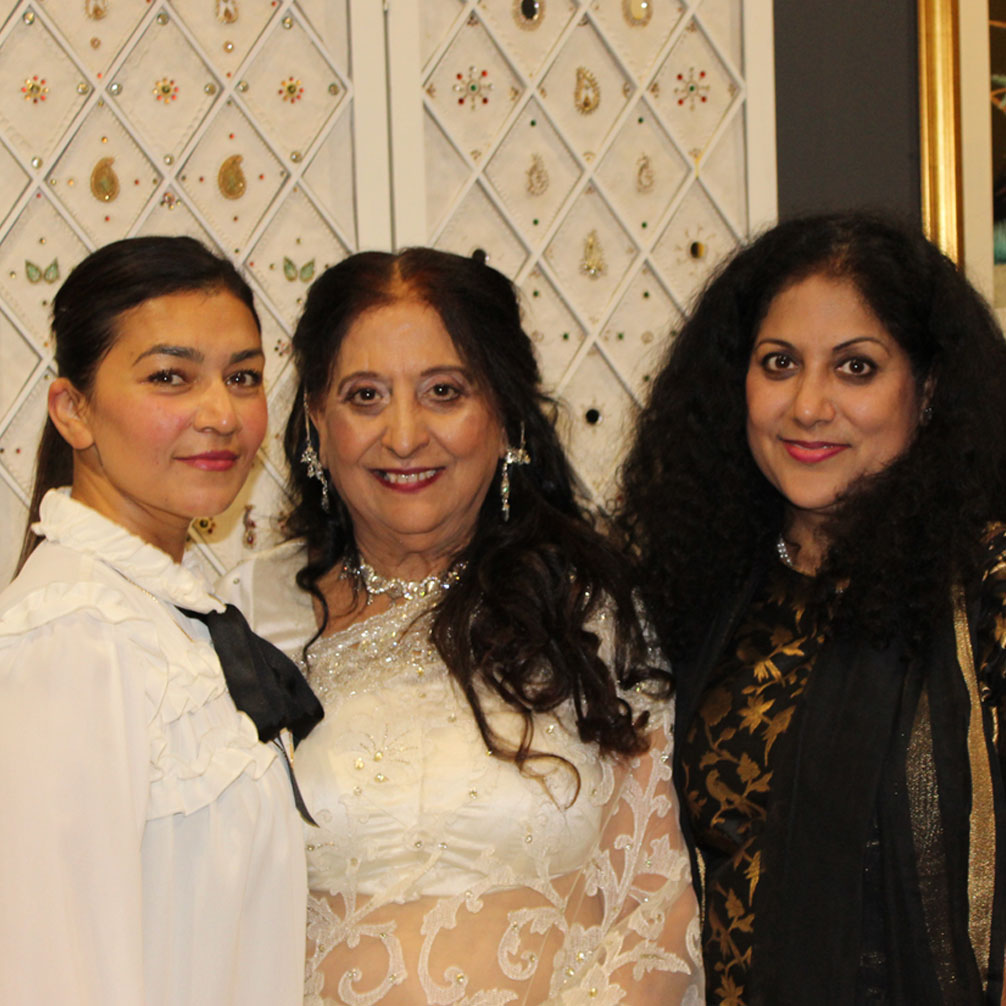
Ranbir Kaur with the exhibition curator Esen Kaya on (left) Padma Rao Director of Sangini and facilitator of the exhibition on the (right).
ARTISTIC SYMMETRY
Written by: By Dr. Christopher A. Johnson
Director, Global Entrepreneurial Development Services Ltd
Growing Phenomenon of Ethnic Enterprise Arts. Since the last century, there has been an exponential profusion of arts, cultural and innovation, emanating from largely populated ethnic communities.
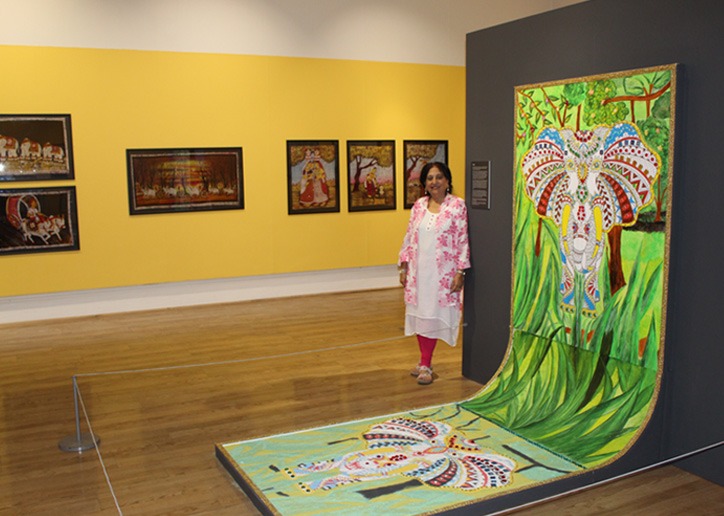
Almost unknown, this phenomenon has given rise to the notion that the instinctive creativity of minorities, is a pervasive heritage that ought to be celebrated. This sector of commerce and industry, is a veritable outlet for unsung, disengaged or under-served communities especially within inner-city areas in Britain.
On the 12 October last, the Sunderland Museum and Winter Gardens hosted, a landmark exhibition of UK-based Indian Rangoli Artist, Ranbir Kaur. Titled “Life in Colour: Ranbir Kaur”, the exhibition fused colourful textiles using traditional techniques from embroidery and mirror work to doll-making. ‘Rangoli’ is defined as ‘traditional Indian decoration and patterns made with ground rice, particularly during festivals’. The central focus of the exhibition, was Kaur’s Rangoli’s intricate pattern of coloured sand, marbles, mirrors and buttons, to mark her 30 years as an artist.
Her personality is illustrative of the challenge of being a female, Indian international artist of adult children (also women) and grandchildren. “Bringing up my children was very difficult since I had to divide my time between different continents, promoting my work and still making time for them”. Conversely, the enormity of her contribution to art and culture, typifies the dignity, honour and respect shown to other cultures, customs and traditions (medieval and contemporary) across continental-regions and other far-flung societies.
In Kaur’s speech at the exhibition launch, her words “my work has been done”, may have sent reverberations ‘down the perceptive spine’ of many public curators, archivists, galleries and other mainstream institutions. These authorities have yet to offer genuine recognition to the talent of minority artists, more so, the power and vitality of their various endeavours. Much of the hype regarding minority artists for example, tend to focus on popular news presenters or other media figures -men and women -who feature in mainstream-sponsored documentaries. However, few if any, minority craftivists are featured in such program ‘packaging’.
An ACE Report (2016) highlighted ethnic anomalies in the artistic workforce even though it acknowledged some upward movement in statistical terms. Nevertheless, only 17% in England’s 663 national portfolio organisations represent ethnic groups. The figure for minorities in major partner museums, is under 10% despite a small representational increase.
Kaur’s exemplary meta knowledge and experience of visual artistic symmetries, also demonstrate the characteristic features that many ethnic artists and cultural producers embody. In viewing Ranbir Kaur’s historic exhibition that was also witnessed by an appreciative yet befuddled audience- viewers from all over the country, one can only contemplate that these qualities are intrinsic to the durable potency of her artistic and cultural avocation and vocation. They include: self-determination, networking, cultural diffusion, aesthetic discipline, professional pride and a relentless pursuit of artistic excellence and cultural prudence, in recognition of, and for the other.
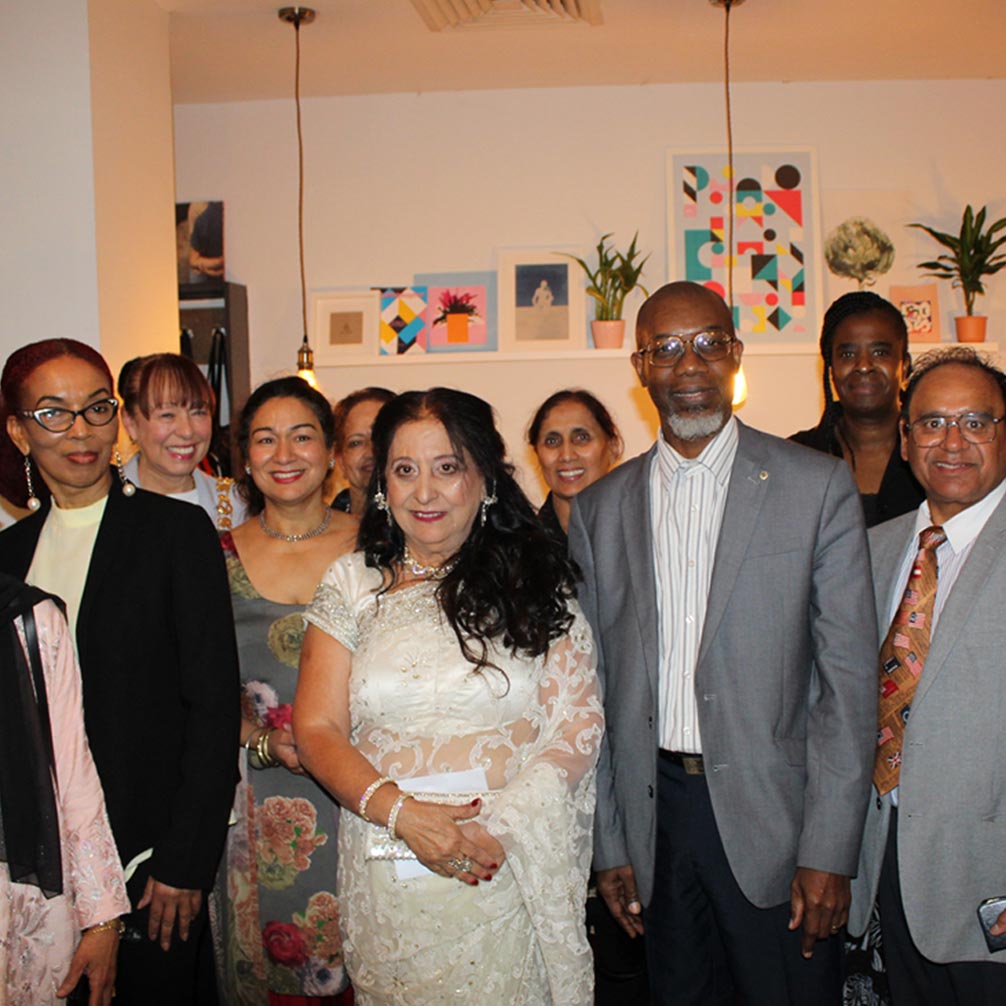
Ranbir, Dr Johnson and the CEAL team waiting with excitement for the exhibition to be opened.
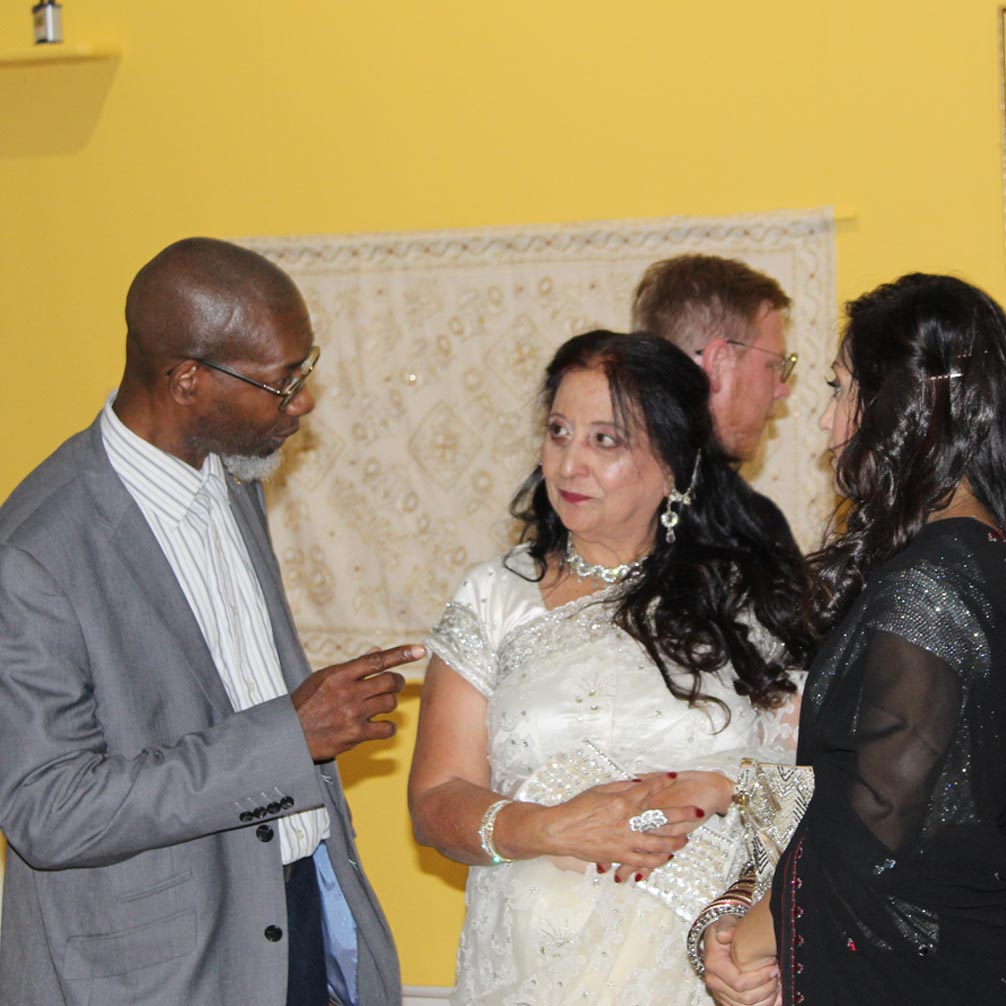
Dr. Johnson discussing with Ranbir about the traditional techniques used in her art.
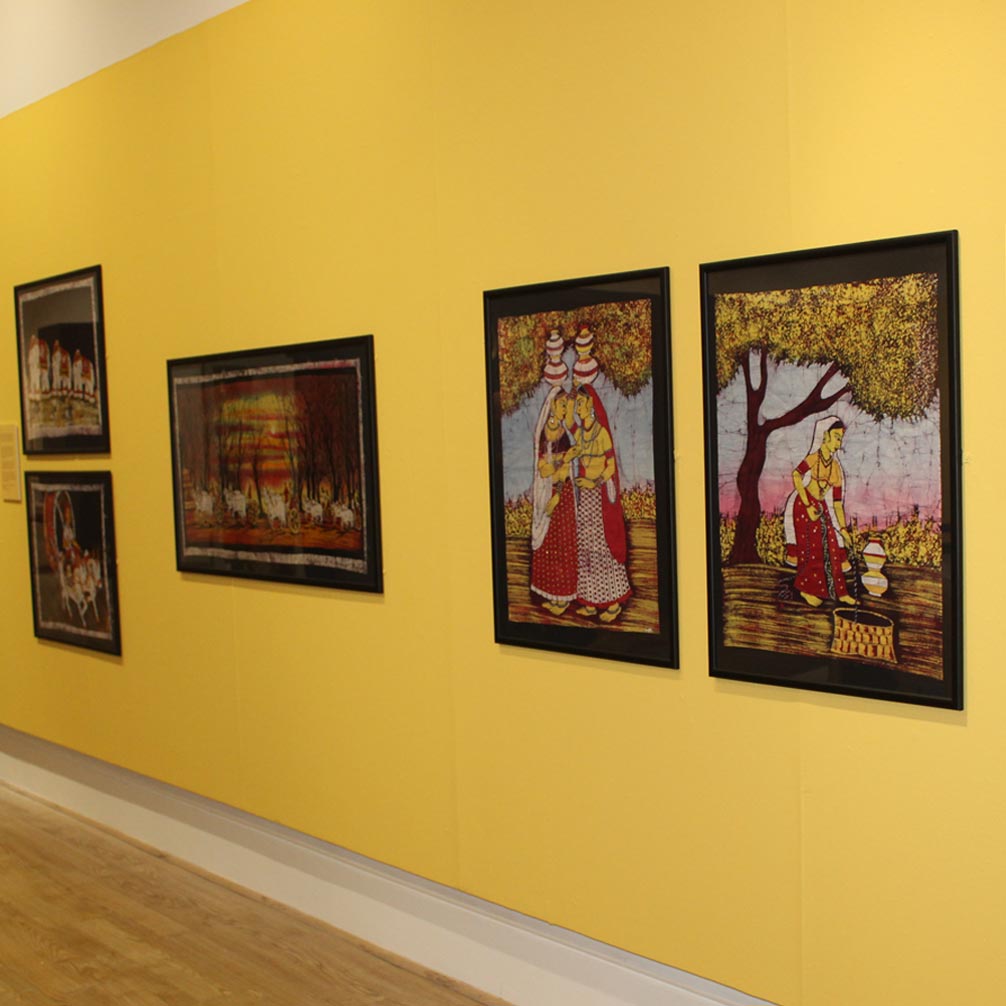
Just a sample of some of the wonderful creations on display at Ranbir’s exhibition.
INSPIRATIONAL ART
Written by: The Cultural Spring
An internationally-respected artist will celebrate 30 years of working in communities around the world with an exhibition in Sunderland.
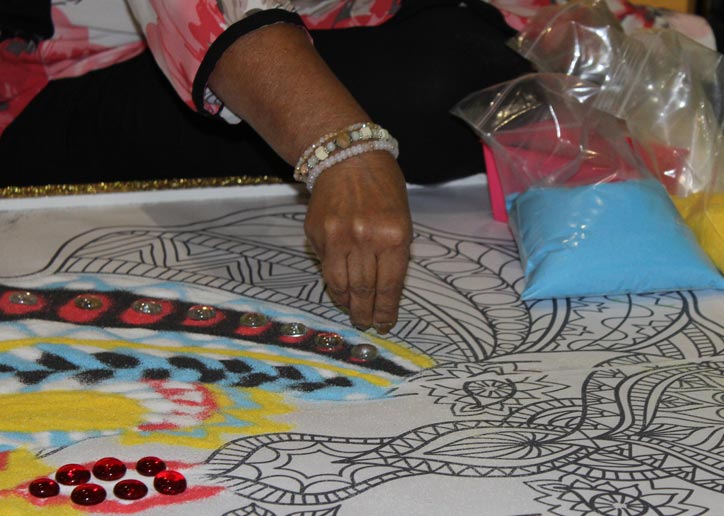
Ugandan-born textile artist Ranbir Kaur will mark three decades of working in the rangoli tradition with an exhibition starting on Saturday, October 13 at Sunderland Museum, Library and Winter Gardens. The exhibition, Life in Colour, will run until Sunday, January 6, 2019.
Rangoli is a traditional Indian art form used to decorate the ground in front of houses and places of worship to attract the Hindu Goddess of Wealth, Lakshmi. It is usually made for festivals and special celebrations. Ranbir has taken this traditional art and adapted her approach according to the space she works in. As well as using traditional materials and patterns, she creates stunning contemporary designs using materials not usually associated with this art.
Although she has exhibited her work extensively in museums and galleries across the UK, this retrospective exhibition is the first time that Ranbir’s life as an artist has been celebrated. The exhibition brings together a wide range of textile pieces made using traditional techniques from embroidery, filigree, and mirror work to story banners and doll-making, all inspired by her South Asian heritage.
The central focus of Life in Colour will be an impressive site-specific rangoli, created with coloured sand, marbles, mirrors and buttons, especially for this retrospective exhibition.
Ranbir is in the Guinness Book of Record for creating the largest rangoli and the first ever floating rangoli on the water with British Water Ways and Craft Space. She also received the ‘Jewel of India’ award in recognition of her outstanding achievements and contribution in keeping Indian culture alive in the UK.
Throughout her career, Ranbir has shared her passion for colour, texture and design, creating an impressive portfolio of projects. She has worked with diverse communities across the UK and, through the design and installation of site-specific rangolis, in many countries across the globe, from Europe to Australia.
Ranbir said: “This exhibition has been two years in the making and I am so pleased to be finally showing my work here in the North East, especially at the Sunderland Museum and Winter Gardens. This retrospective presents pieces that haven’t been seen by the public before. It brings together the breadth of my work I have produced over the years and every piece has a little history, a story to tell. I hope that through this exhibition the public would get a glimpse into my world – my world of colours and patterns.”
Abid Hussain, Director of Diversity at Arts Council of England, said: “Over a career spanning 30 years Ranbir Kaur has made an incredible contribution to the arts and cultural life of England. Her work has served as an inspiration to so many people across the country including myself.
“Her generosity of spirit and body of work is a testimony to Ranbir the artist but also Ranbir the mother, mentor and community enabler whose work has crossed cultural and religious divides to inspire so many people who would otherwise not have engaged with arts and culture.”
Prior to the exhibition’s opening, Ranbir will host a series of free Art of Rangoli workshops to introduce the art form to Sunderland families. The first will take place at Sunderland Museum and Winter Gardens on Saturday, October 13 (11am – 12.30pm and then 1.3pm – 3pm).
The Cultural Spring will also host a free workshop at the CHANCE centre, 2 Rickaby Street in the city’s East End on Saturday, October 20 (11am – 3pm). To book places at this workshop, log on to the workshops section of the Cultural Spring’s website … www.theculturalspring.org.uk or ring 0191 427 8197.
Further workshops will be held at the Museum between November 5 and November 8. Go to www.seeitdoitsunderland.co.uk/sunderland-museum-winter-gardens for details.
This exhibition has been made possible with generous support from Arts Council England National Lottery Funds, Sunderland Museum, Library and Winter Gardens and Friends of Sunderland Museum.
The Cultural Spring is an Arts Council England (ACE) funded project, which aims to increase participation in the arts both in Sunderland and South Tyneside. The Cultural Spring’s four partners are the University of Sunderland; the Customs House, South Shields, Sunderland’s Music, Arts and Culture (MAC) Trust and Sangini, a women’s organisation. The project works with five wards in Sunderland and five in South Tyneside.
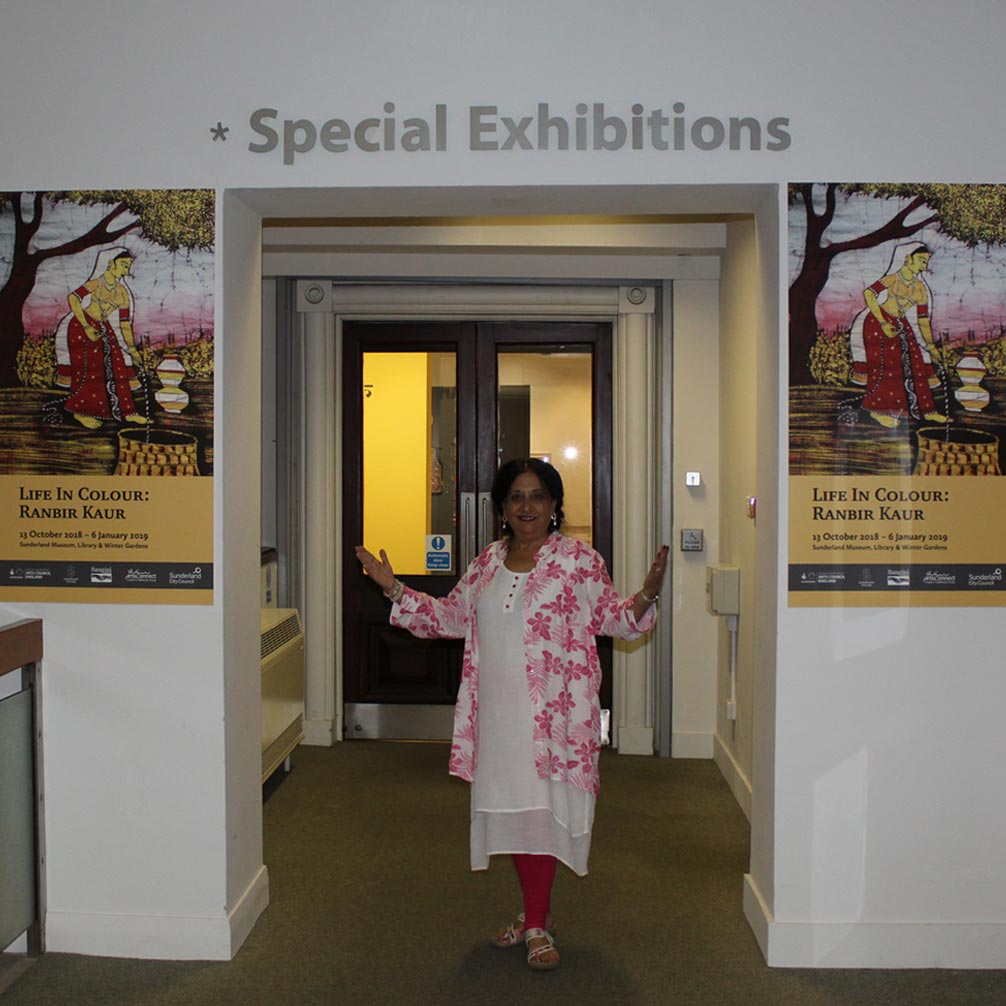
Ranbir at the entrance to her Life in Colour exhibition at The Sunderland Museum & Winter Gardens.
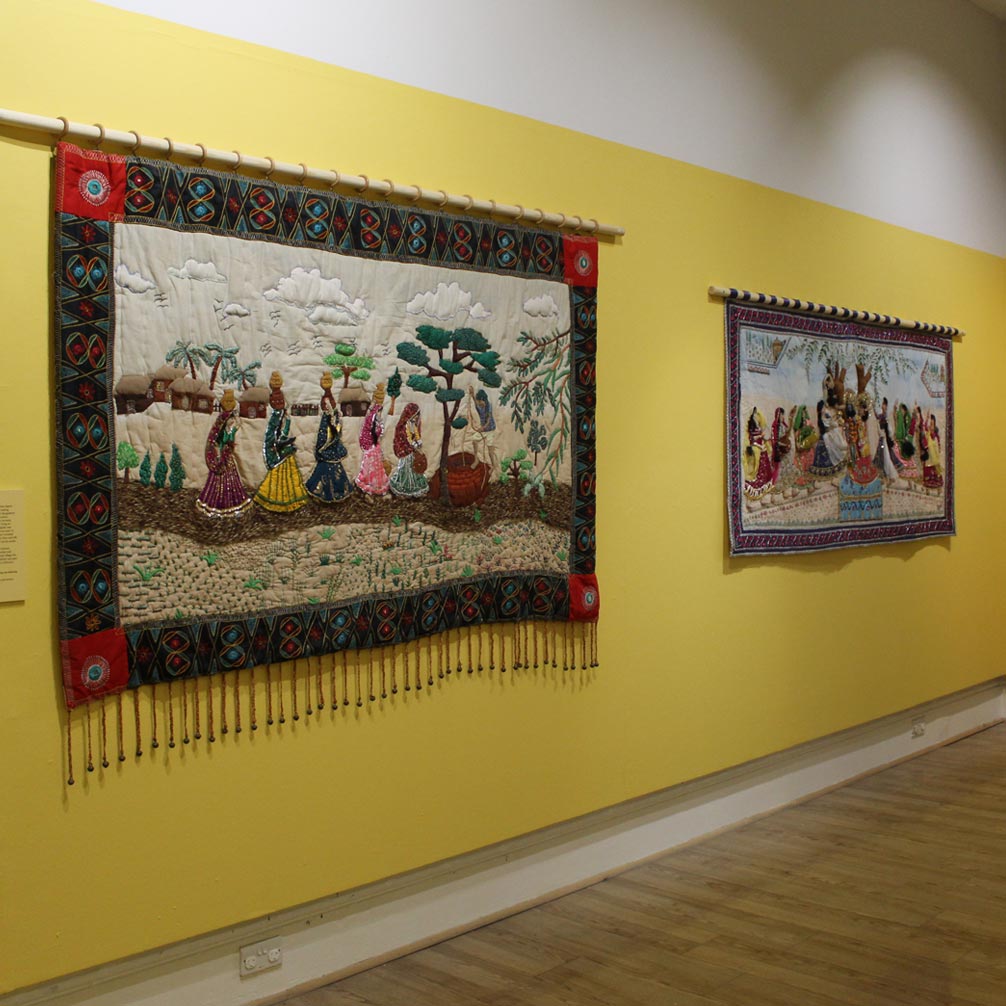
Ranbir’s large wall tapestries.
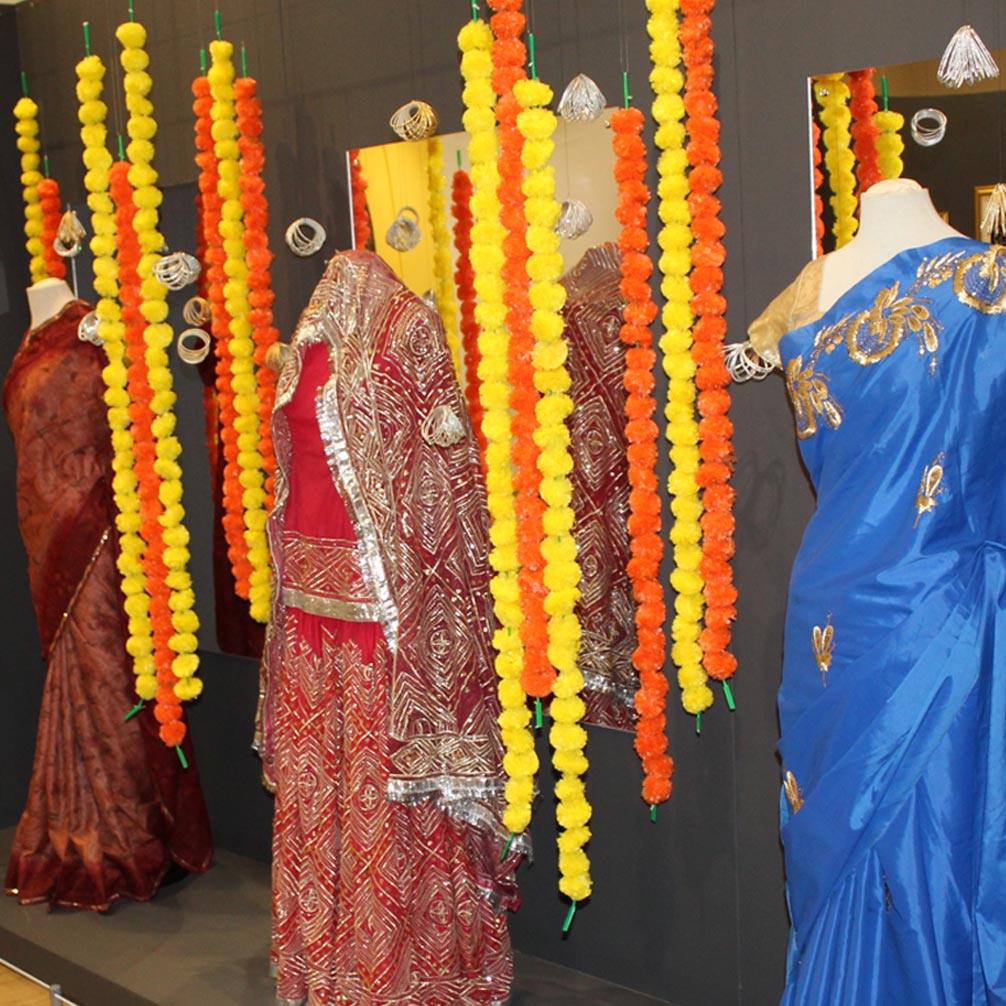
A beautiful display of traditional saree’s including Ranbir’s wedding dress (middle).
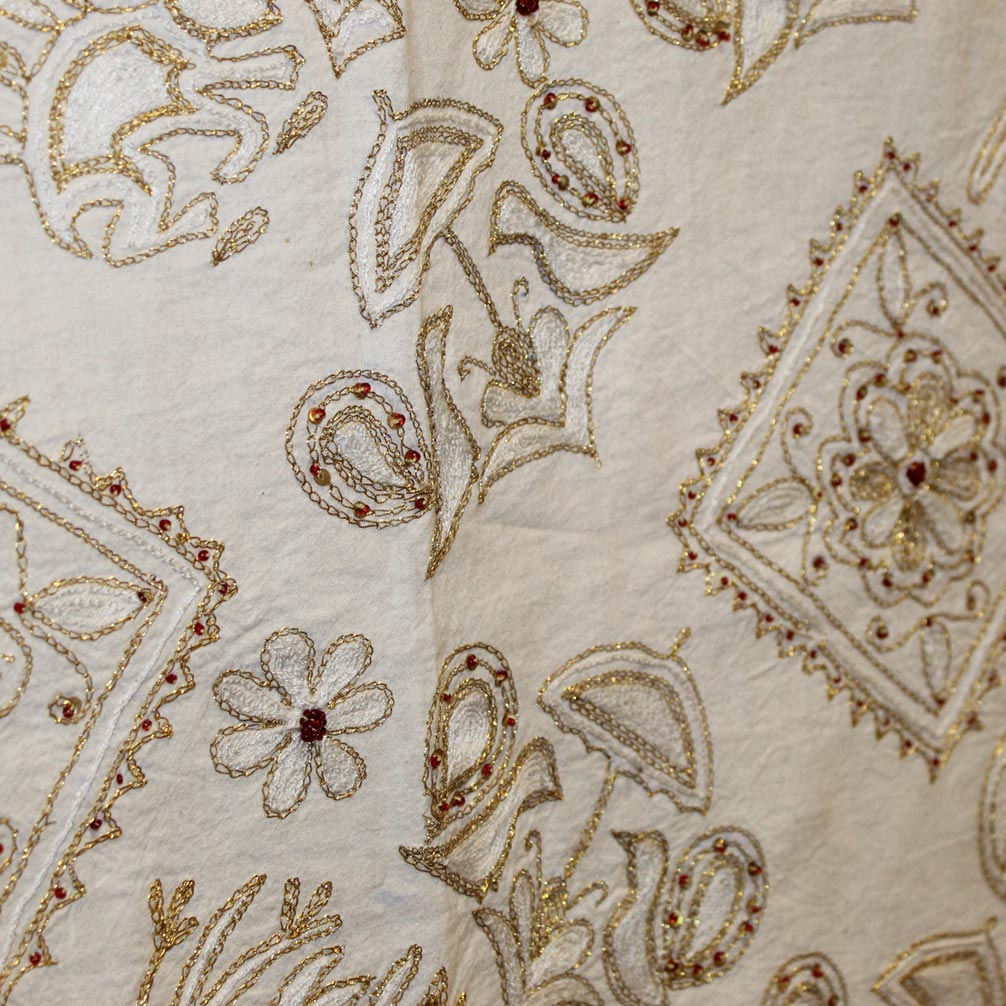
Close-up of the intricate stitching techniques demonstrated in Ranbir’s wonderful work.
Hire Me
